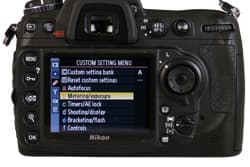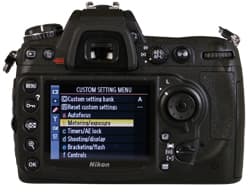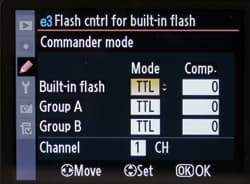DSLR Menu Guide – Custom functions
Most DSLRs offer a range of Custom Functions. These alter the way the camera is set up so you can customise it to your own tastes.
Common menu options include the ability to select whether you want exposure compensation in half or third stop increments; whether you want your focus ring to go clockwise or anti-clockwise to infinity; which of your front and rear input dials you want to use for shutter speeds and which for apertures, and so forth.
You may have an extra button on the body to which you can assign one of a variety of functions, such as Depth of Field Preview.
DSLR Menu Guide – File management
Digital camera files often begin with a set of letters such as DSC, but you can often change this to anything you like – such as your initials – using the File Naming option.
It’s very useful in scenarios where several photographers may share the same archive.
File Numbering on the other hand lets you choose whether, when you insert a new card, you want the numbers to continue from where you left off, or start again.
DSLR Menu Guide – Noise Reduction
A major problem facing low light photographers is noise, which appears on images as distracting speckles, like film grain, that destroy the detail. See our article What is Noise for more information on this.
In order to record a correct exposure, either a high ISO or a long exposure time must be set, both of which increase the image noise.
Most DSLRs offer two noise-reduction features in the menu.
High ISO NR is designed to combat the noise caused by shooting at high ISO, while Long Exposure NR is designed to reduce the noise resulting from using very slow shutter speeds.
Both types take time to apply so you’ll have to wait for the image to finish processing before you can take another shot. If you prefer, you can leave these settings off and perform your noise reduction using software on your PC.
DSLR Menu Guide – Interval Timer
The Interval Timer sets the camera to make a series of exposures at pre-determined intervals.
You can use this to take a series of images over a number of seconds, minutes or even hours.
This setting is perfect for recording the passage of time such as the journey of the moon or clouds across the sky, or the opening of a flower.
DSLR Menu Guide – Multiple exposure
The Multiple exposure option lets you take several images on the same frame.
This was a popular feature in the days of film, but Photoshop turned this technique into more of a post-processing feature.
But you can do it in camera if you want to.
DSLR Menu Guide – Flash settings
Some DSLRs offer an off-camera flash feature, which enables you to control and trigger, from the camera, a remote dedicated flashgun or several flashguns placed within range.
The menu will give you the choice of how you want this set up.
You can choose what power ratios you want to set, and whether you want your built-in flash to fire or not.

Some cameras enable you to use your dedicated flashgun off the camera, for more natural results












